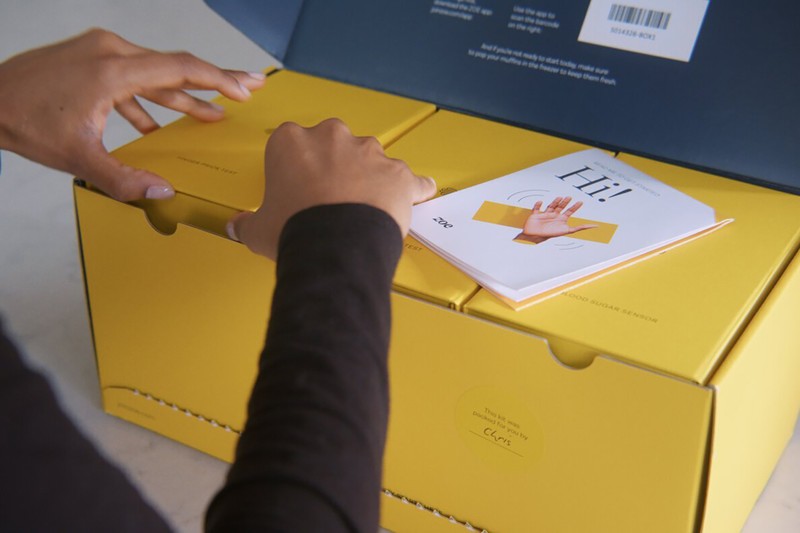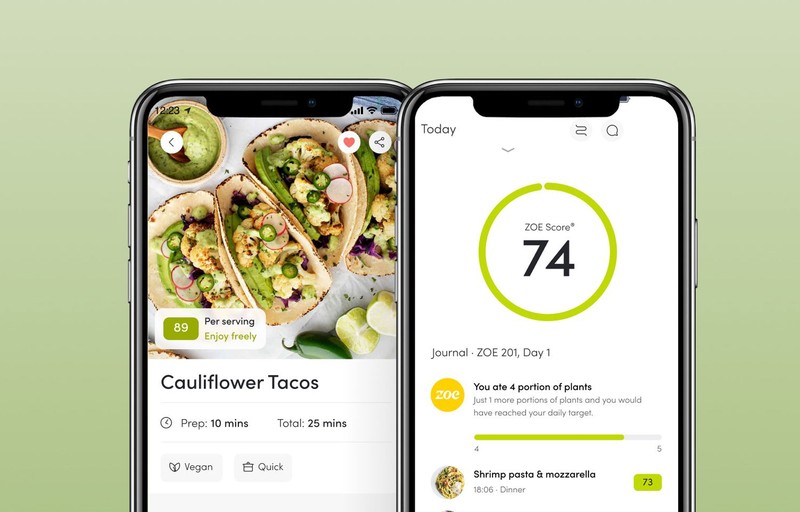

The Gold Edition Tests The Diet Changing The Way We Think About Nutrition
The Background
If you’ve spotted someone in your gym or yoga class wearing a yellow sticker on the back of their arm, they are one of the 100,000 people in the UK who has signed up to ZOE, the personalised nutrition programme co-founded in 2022 by Professor Tim Spector from the genetic epidemiology department at King’s College London. As the head of a worldwide twins study, he found that despite twins having identical genetics, the way they react to food was completely different. This led him to want to find out how personal biology impacts our metabolism and gut health. You may remember that Professor Spector became a household name during the pandemic when the ZOE app was initially a symptom tracker, providing vital data on the spread of Covid.
The Concept
ZOE has nothing to do with allergies or food intolerances but is designed to test your individual biology to give you a unique list of foods that are best for your body. The long-term, overall aim is to stabilise your blood sugar and fat levels and boost your gut bacteria. Why are these things important? Blood sugar spikes and high blood fat can trigger inflammation, weight gain and diseases like diabetes and heart disease; and gut bacteria maintain the health of our immune system and affect how we break down food. The gut gets colonised by many microbes at birth and the composition of the gut microbiome is mostly dictated by what we eat but also by other factors, such as where we live, who we interact with, the medication we take, hygiene conditions and our level of exercise and stress. By eating the right foods and living the right lifestyle we can partly shape the composition of our gut microbiome which, ZOE says, is key to achieving a healthy weight and improving our long-term health.
How It Works
Once you’ve signed up, you’ll receive your very stylishly packaged ZOE kit which, due to high demand, can take a few weeks to arrive. The first phase involves wearing a CGM (continuous glucose monitor) for two weeks, which you cover with the above-mentioned yellow patch. The water-resistant sensor (you can shower but can’t swim or submerge it in water), which is used by diabetics to monitor blood sugar spikes and dips, is linked to an app so ZOE can see in real time how different foods and physical activity impact your glucose levels. You also choose a testing day, fast overnight and eat some vegan cookies (which have recently replaced the signature ZOE muffins they used to use, thus allowing those who are vegan/plant-based to participate). These contain a specific profile of carbs, fats and proteins to see how your body reacts to these nutrients. Then there are two tests in your kit: the gut health test involves collecting a small poo sample and the blood fat test involves a simple finger prick test – both of which you send to their lab for analysis.
The Results
During the two-week period you are wearing your CGM, you log all your meals and, with this data and your test results, ZOE can predict the impact of foods on your blood sugar levels, your blood fat and your gut health. They are also able to score every food (from 0-100) and provide you with a personalised scoring system that will guide your food choices. These results arrive a few weeks later in a lengthy document and tell you all you need to know about your gut bacteria and how your body responds to fats and sugars.

Putting It Into Practice
As you embark on the programme, you begin to understand how foods impact your individual biology. You continue to log your meals on the ZOE app and aim to keep your average daily score over 60, aiming for 75 after a couple of months. The app is very user friendly and helpful – akin to having a nutritionist in your pocket. It has daily lessons and quizzes to help you along the way and teach you how to combine foods and build meals that keep you satisfied and energised, while feeding your gut bacteria more of the foods they love.
The list of foods and recipes on the app is vast and each has a unique score out of 100 for how good or bad they are for you based on your test results. There are also lists of your gut suppressors (the baddies) and gut boosters (the goodies). Another very useful feature of the app is the bar code reader which means you can scan foods in the supermarket to see how they fit into your programme. You can also add your favourite recipes to the app – this can be done by typing out the ingredients, photographing a recipe or you can import a recipe by pasting the URL.
The Benefits
ZOE claims the benefits are immediate and, while the aim is overall health and not weight loss, people who stick to their nutrition programme for three months lose an average of 4kg. They also say that most people have more energy, don’t feel hungry, sleep better, have fewer cravings, better digestion and easier bowel movements.
A recent addition to ZOE is the gut bacteria re-test (another stool sample) which is currently being rolled out to members who tested over four months ago and who have adhered as closely as possible to their personalised nutrition advice for a minimum of two months. This will update your scores, so to take full advantage of this and to see how your gut microbiome has been impacted, it is important to log your meals regularly and to follow your programme.
Our tester Jeannette, age 66, on how she got on and how effective ZOE proved for her:
Since having my children in my 30s, more often than not I have been a stone over my ideal weight and, over the years, I have tried every new diet that has come along. Nevertheless, before starting ZOE in the summer, I felt I already ate healthily (lots of fruit and veg) and exercised regularly. But I frequently experienced those 4pm slumps which had me reaching for the chocolate biscuits, slept fitfully and lacked energy. I was also a carnivore and loved nothing more than a sirloin steak, roast lamb and pork and other things like salamis, chorizo, sausages, snacks and crisps. I probably only ate fish once or twice a month.
During the two-week testing period, I thought it best to continue eating my normal diet to see how it scored and I did notice my CMG having massive spikes at times (for example, when I tucked into a prawn sandwich on malt bread at Wimbledon). You are also encouraged to experiment with food sequencing, food combinations and exercise to see what effect that has on your blood sugar levels.
So, it was with some trepidation that I awaited my results which arrive via email in the form of two lengthy PDF documents. The first document details the quantity of good versus bad bacteria in my gut and scores my microbiome in comparison to other people of my age and sex. The good news is that I score 78 which, according to ZOE, is excellent. On to the second document – the news is less good. My blood sugar control score is 32 (poor), which means that my body is less able to handle blood sugar after I eat certain carb-rich foods; my blood fat control score is 39 (also poor), which means that my body is less able to clear fats from my bloodstream efficiently. But the reassurance is there. I’m told not to worry as ZOE will teach me how to eat in a way that will help me manage my blood sugar responses and find high-quality fats and teach me how to space my fats throughout the day.
I also get a score for my regular diet based on my logged meals during the testing period. Better news – a score of 56 (good). I then spend hours going through the app and my personalised, colour-coded (dark green being the best) food scores, list of gut boosters and suppressors, all of which makes fascinating reading. Top of my gut boosters are nuts (they score 100/100), mushrooms (100), salmon (90), strawberries (80); gut suppressors include most meats (all fall under 50) down to orange juice (6), sausages, white bread and salami (all 0). Under other sections, beans and legumes score in the high 90s and 80s, as do avocados (100), fresh tuna (91), humous (84) and several other things I love. So, it’s not all doom and gloom.
I ask Dr Federica Amati, head nutritionist at Zoe, to talk me through my results. While my gut microbiome score is excellent, I don’t have a massive diversity of bacteria, which is not a problem as I have more of the good bacteria. But I can add to this by eating more fermented foods like kefir and sauerkraut, she tells me. “The microbiome loves being improved, and it will happen if you follow ZOE’s advice and continue to eat fibre-rich foods and a variety of fermented foods and plants,” she adds.
Onto my other scores and she says it is quite common for women post menopause to have poor blood sugar and fat responses. In fact, it is quite rare to have good everything and my sugar and fat scores are within the norms for women of my age in this country. “It’s normal to lose metabolic flexibility with age,” says Federica. “The blood sugar response is the one that has the biggest genetic component – up to 40%,” she tells me. She adds that it’s harder to shift one’s blood glucose response to be better but it’s important to ensure one is not stressing it and to “eat with this new insight and knowledge in mind”. The blood fat response, on the other hand, is very responsive to lifestyle changes, so I can improve my score via diet and movement. “Exercise is crucial,” she stresses. And this is important as having high amounts of fat hanging around in your blood after meals is problematic for the vascular system, she explains.
She also reassures me I don’t have to worry about following ZOE 24/7. “The biggest thing ZOE is clear on is that perfection is not the goal, and it’s consistency that results in long-term benefits. So even if you have to reduce some of the foods you love, the foods that you are adding will give you satisfaction and that is how you are able to maintain that change,” she tells me. “Finding balance is key so, once you have a good foundation, stick to the plan 80% of the time and enjoy what you like the rest of the time, leaving room for life to happen. Remember that having a croissant with jam every now and again is not going to change that 80%,” she adds. Her top tip is to go for a walk after that croissant or after a meal containing more simple carbs and sugar than usual, as using my muscles will help get rid of the sugar in my blood.
For someone who loves eating out, she offers another great tip: “ZOE is all about your approach to food, there is no plan as such. A piece of advice I often give if you are eating in a restaurant is to choose your veg first, so look at the side dishes first and then look at the mains. This will often change the whole balance of your meal. Even if you’re having mac and cheese but you have your veg too, it becomes a more complete meal. Most women are programmed to aim to eat less but having some healthy sides as well, rather than just the mac and cheese, means you’ll be less hungry later and the overall quality of your meal is more beneficial.” She adds a very important point: “Don’t worry about calories and forget about going hungry if you want to lose weight”, which is music to my ears.
Four months in, I am still logging all my foods religiously and I’ve learned to eat a handful of nuts or make sure I have a portion of beans and veg if I want to have steak for supper or a few glasses of wine (red is recommended – Malbec scores a whopping 62, whereas a glass of Picpoul scores a miserable 42). I have made some changes I once thought impossible – for instance, I now eat brown rice, wholewheat pasta and loads of pulses, beans and tinned fish like mackerel and sardines.
What you’ll want to know is, how do I feel? The good news is that I have lost 4kg, have not once felt hungry, have a bit more energy but my sleep is still erratic but definitely improved.
And finally, it’s not cheap, so is it worth it? While some may think that a lot of it is common sense, for me it’s been eye-opening to see how my body responds to certain foods and how I can combine healthy foods with unhealthy foods to give my body better responses. I hope that in time I will stop being quite so obsessed with logging everything that passes my lips but for now I love to congratulate myself on my scores, even when I’ve had a few glasses of wine! So yes, I would recommend it, but you have to be committed to logging meals and sticking to it.
*Federica Amati’s book, Recipes for a Better Menopause, was published last month and can be ordered here. It also contains recipes by Jane Baxter which fit in well with most people’s ZOE plans.
To sign up to Zoe, visit Zoe.com. Membership plans start from £24.99 per month plus £299.99 for the test kit.
DISCLAIMER: Features published by SheerLuxe are not intended to treat, diagnose, cure or prevent any disease. Always seek the advice of your GP or another qualified healthcare provider for any questions you have regarding a medical condition, and before undertaking any diet, exercise or other health-related programme.
DISCLAIMER: We endeavour to always credit the correct original source of every image we use. If you think a credit may be incorrect, please contact us at info@sheerluxe.com.


